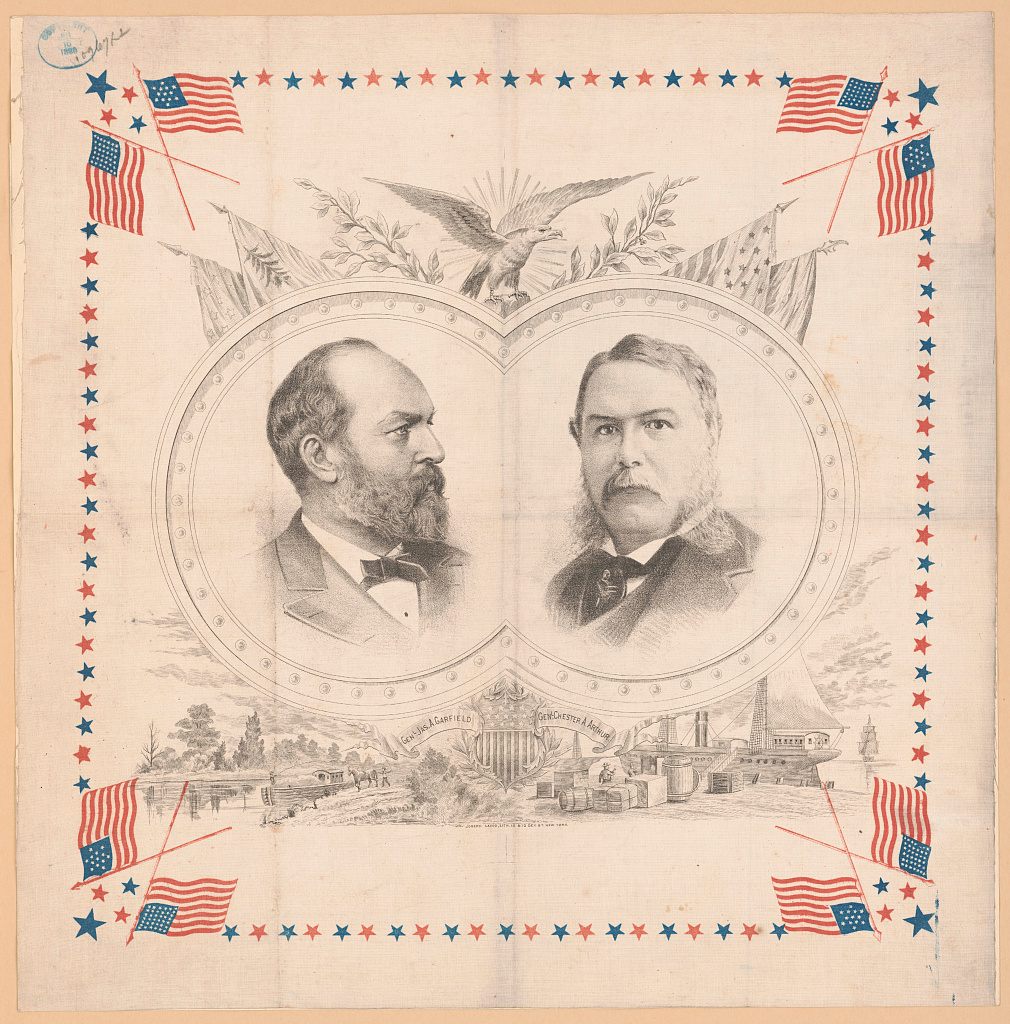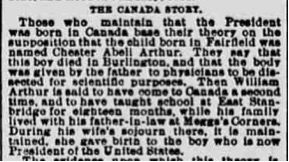Was Our 21st President Secretly Canadian? 19th Century Birthers Sure Thought So

A print for the James A. Garfield and Chester A. Arthur Presidential campaign. (Photo: Library of Congress)
In late December 1881, a stranger appeared in the small town of Fairfield, Vermont. The New York Times reported that the man, Arthur P. Hinman, was “ostensibly collecting materials for a biography of Vice-president-elect” Chester Alan Arthur, a Republican nominated on the ticket with James Garfield. But the Times speculated that Hinman was really in town for a more nefarious reason: to prove that Arthur was born in Canada, thereby making him ineligible to serve as the President’s second in command.
Hinman’s investigation into Arthur’s birth story, allegedly set into motion by the Democratic Party, reveals the historical roots of the modern “birther” movement in American politics. Chester Arthur was the third of six presidents in U.S. history to have at least one foreign-born parent—Arthur’s father William was born in Ireland, and the family had indeed traveled around the area, including across the border to Canada, for William’s work as a teacher and clergyman.
This makes him a historical outlier in a political system that has enshrined the laws of citizenship into the rules for the country’s highest office. The birthers of the 1880s had similar goals to today’s movement: to plant a seed in the minds of voters that the candidate is not to be trusted on policy or personal matters.

A depiction of President Garfield’s assassination. (Photo: Public Domain/WikiCommons)
Rumors about Arthur’s eligibility for high office had been circulating for months prior to Hinman’s arrival in Vermont. On September 21, 1881, two days after President Garfield died and Arthur assumed his position, the New York Sun ran a feature detailing Arthur’s personal history and the suspicious conditions of his birth in northern Vermont.
To make things even murkier, historians also disagreed on his birth year, with some citing 1829 and others citing 1830 as the correct date (most historians now agree that Arthur was actually born in 1829).
The article contained interviews with residents of the various towns purportedly inhabited by the Arthur family. “The most valuable statement was obtained from Dr. C. L. Case,” wrote the reporter. “[His] statements deserve particular attention because he is he is quite clear as to details and because he is a citizen of high standing in Brandon [Vermont].”

An except from a New York Sun story from September 21, 1881, two days after President Garfield died, detailing the suspicious conditions of Arthur’s birth. (Photo: Public Domain)
Dr. Case, along with other residents of the area, remembered the birth of a boy named Arthur in 1829 or 1830, but confusion about the newborn’s middle name fueled rumors about where he had been born. The Sun reporter addressed the conspiracy of Arthur’s Canadian birth story, writing that despite a lack of records relating to the Arthur family in Vermont, “those who maintain that the President was born in Canada base their theory on the supposition that the child born in Fairfield was named Chester Abell Arthur” instead of Chester Alan Arthur.
The reporter discovered that some residents thought that Chester Abell Arthur had been born in Vermont, died as a newborn, and his Canadian-born younger brother Chester Alan Arthur had assumed his identity around 1832.
However, the Sun found that these rumors were largely unfounded; there was neither proof that Arthur had been born abroad, nor any evidence of a brother’s birth around that time. “The whole case is conclusively settled,” the Sun proclaimed at the end of the feature. “The controversy over the birthplace of the man who last November was elected Vice-President is disposed of. President Arthur was born in the State of Vermont.”
But while he may have been truthful about his birthplace, Chester Arthur had some experience bending the truth for political or social gain.

Chester A. Arthur, photographed in 1882. (Photo: Library of Congress)
In Gentleman Boss: The Life of Chester Alan Arthur, historian Thomas C. Reeves writes that during the 1880 election, Democrats spread rumors of Arthur’s birthplace alongside other smear tactics that called into question his morality and character. Reeves writes that Democrats considered Arthur to be “the lowest sort of political hack, a prince of spoilsmen, a ballot-box stuffer whose every move had to be scrutinized by those interested in honest elections.”
During the primary and general elections of 1880, Chester Arthur was deeply embroiled in a battle between two warring Republican factions; the Stalwart group, which supported New York Republican bigwig Roscoe Conkling and a system of party patronage, was at odds with the Half-Breeds, a group led by James Blaine that supported a merit-based system for civil service appointments.
Arthur was a Stalwart, loyal to Conkling and a beneficiary of the Republican “machine” in New York. He rose through the ranks of state government through a combination of social connections and political favors, eventually winning the position of Collector of the Port of New York. At the 1880 Republican National Convention in Chicago, Arthur’s New York connections and his Stalwart affiliations made him an ideal candidate for the vice-Presidential nomination alongside the Half-Breed moderate James Garfield, a combination designed to win the strategically important state of New York.

An engraving of Judge Brady administering the Presidential oath to Vice-President Arthur, at his residence in New York, September 20, 1881. (Photo: Library of Congress)
Arthur was expected to remain loyal to Conkling while serving in the White House, but once in office he became a supporter of civil service reform, in opposition to Conkling and his old friends. He wasn’t a flashy politician, and did little public campaigning during the 1880 elections. His main strength lay in organizing, and he coordinated campaign rallies and fundraising efforts across the country.
Reeves points out that most political players paid no mind to the birthplace rumors surrounding Arthur, because they assumed there was little danger of Garfield being unable to man his post due to health concerns—no one foresaw Garfield’s untimely death at the hands of Charles Guiteau in July 1881, who was quoted in the New York Tribune telling arresting officers “I am a Stalwart, and want Arthur for President!”
Even though Arthur never directly addressed the speculation around his birthplace, a reporter made a note of a speech he gave following the 1880 election. In a piece published in the Times on February 12, 1881, Arthur allegedly boasted to a roomful of supporters:
I don’t think we had better go into the minute secrets of the campaign, so far as I know them… while I don’t mean to say anything about my birthplace, whether it was in Canada or elsewhere, still, if I should get to going about the secrets of the campaign, there is no saying what I might say to make trouble between now and the 4th of March.”
Aside from this, Arthur never directly addressed the rumors during the campaign.

Donald Trump, one of the modern day “birthers” who questioned President Obama’s birthplace. (Photo: Gage Skidmore/WikiCommons CC BY-SA 2.0)
Hinman, the man who went to Vermont to sniff out the “truth” about Arthur, eventually collected enough “evidence” to write a short book, titled How a British Subject Became President of the United States, published in 1884. It was essentially a polemic that focused on Arthur’s naming discrepancies and provided flimsy reasoning to discredit Fairfield, Vermont, residents who remember Arthur’s birth (“Several persons are now living who were aware of the birth of this boy,” Hinman writes, “and they are probably mistaken.”).
This publication date was likely intended to coincide with the general election of that year, in which Arthur was expected to take part. By that time, however, Arthur posed no real threat to his internal opponents or the Democrats; he avoided campaigning for his primary nomination, and James Blaine was named the Republican nominee instead. Blaine went on to lose the general election to Grover Cleveland, ushering in a new era of Democratic control over the White House. Arthur, suffering from Bright’s disease, died in November 1886.
Today, there is still a glimmer of suspicion regarding the birth of Chester Arthur. As recently as 2009, Associated Press journalist John Curran revisited the story, traveling to Vermont and investigating the documents available on Arthur and his family. Curran quotes earlier researchers’ arguments that the Canada story is untrue, but also notes that there is no conclusive evidence proving that Arthur was born in Vermont, either.
Regardless of the truth, the tactic of crying foul on a candidate’s birthplace holds a unique place in American politics, and the case of Chester Arthur shows us just how far politicians can go to reveal a foreigner among us–even creating one out of thin air.








Follow us on Twitter to get the latest on the world's hidden wonders.
Like us on Facebook to get the latest on the world's hidden wonders.
Follow us on Twitter Like us on Facebook